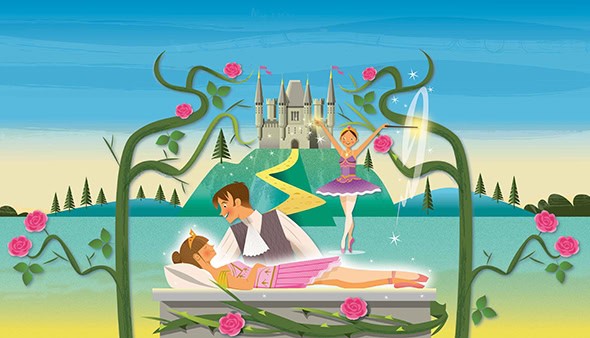English National Ballet’s My First Ballet: Sleeping Beauty
Posted: April 29th, 2019 | Author: Nicholas Minns | Filed under: Performance | Tags: Anna Pavlova, Antonio Castilla, Ballet For All, Charles Perreault, English National Ballet, My First Ballet, Sebastian Charles, Sir Frederick Ashton, Sleeping Beauty | Comments Off on English National Ballet’s My First Ballet: Sleeping BeautyEnglish National Ballet, My First Ballet: Sleeping Beauty, Peacock, April 17

I attended the matinée of English National Ballet’s My First Ballet: Sleeping Beauty at the Peacock Theatre with the daughter of a friend, Eva, who is studying ballet in Sussex; at 13 she appeared quite mature amongst the audience of little girls in tutus. When Sir Frederick Ashton first saw Anna Pavlova at the Teatro Municipal in Lima he was also 13. The experience of seeing Pavlova at that stage in his life, as he reminisced to John Selwyn Gilbert in 1971, ‘was the end of me. She injected me with her poison and from the end of that evening I wanted to dance.’ Pavlova did not distinguish between the ages of her audience; her indefatigable touring around the world gave anyone who wished the opportunity to experience the full extent of her artistry.
In 1964 the Royal Ballet founded a touring group, Ballet For All, that was run by Peter Brinson as a means of introducing new audiences to ballet through a combination of history, analysis and performance. Developed from his lecture demonstrations, Brinson described the format as ‘presenting special programmes, called ballet-plays, which combine words with ballets, actors with dancers and musicians, to inform as well as entertain.’ The cast was made up of two actors, a pianist and six dancers from both the Royal Ballet and Sadler’s Wells Royal Ballet companies. This group toured widely in small-scale venues, giving around 150 performances a year until the company closed in 1979. According to Jane Nicholas, a former Arts Council director, Ballet For All ‘became the most important proselytizing activity in the country in classical ballet.’
In devising the series of My First Ballet — to date there have been four productions based on Cinderella, Coppelia, Swan Lake and Sleeping Beauty — ENB is pitching classical ballet as an entertainment conceived for very young audiences. The series is a collaboration between the company and its school so it’s a pre-professional community outreach program by a major ballet company in this country. The format raises questions, however, on what is considered ‘entertainment’ and ‘educational’ at this target age. For example, although there is no artistic reason for doing so, the story has been adapted for easy viewing; the fairies Carabosse and Lilac are introduced as sisters casting spells on their dolls; Catalabutte is a court painter; the knitting needle becomes a rose, and Desiré and Bluebird are best friends. Ironing out the richness and imaginative scope of both the characters and the story — Lilac’s magical power turns her dolls into ballerinas while Carabosse’s can only create Dark Companions — is ironic given that Charles Perreault wrote his fairy tale with children (of all ages) in mind. And even in its simplified version this production overlooks why Lilac is not aware that her sister Carabosse has not been invited to Aurora’s christening.
The production is hosted engagingly by Sebastian Charles, a master of ceremonies in contemporary dress who does a little bit of magic, narrates the story and translates the balletic mime into words, all of which are traditionally implicit in a full theatrical presentation. While the recorded extracts of Tchaikovsky’s score retain their customary importance, Charles’s intervention reduces the choreography and its interpretation by the dancers to a secondary role. In Ballet For All, even though the classics were abridged and danced to piano accompaniment, Brinson maintained the choreography of the full productions and his dancers were quite capable of performing it. ENB has eschewed both options; Antonio Castilla has arranged the choreography and the dancers are still in training. While this gives them a wonderful opportunity to gain stage experience and to hone their technique (though there were, as Eva remarked, some mistakes), they have not had time to acquire the faculty of taking an audience with them on their journey. Classical ballet is clearly so much more than the ability to execute steps and enchainements to music; the poison Ashton spoke of derived from the artistry of Pavlova herself and not from the works she danced that evening.
So while the enthusiastic attendance confirms the quantitative success of My First Ballet: Sleeping Beauty in fulfilling ENB’s goal to ‘bring classical ballet to a young audience’, the quality of the presentation suggests the imagination of a young audience is not ready for the sophistication of a mature production and the intoxication it may arouse. Nothing could be further from the truth.